According to David Kotok, co-founder, chairman and chief investment officer of Cumberland Advisors, “long-term rates are likely to stay near current levels for quite a while”.
I tend to agree, but I will go even further. Not only will interest rates stay low, but I would expect the 10-Year Note to retrace back to at least 2% over the next 2-3 years. Why?
Again, the forecast above is based on our incredibly accurate mathematical and timing work. This work predicts a severe bear market in US equities between 2014-2017 and a subsequent deep recession. As it is now, inflation is nonexistent as we continue to deal with debt liquidating deflationary forces.
When the bear market hits (we are almost there), the FED will have no choice but to abandon their “tightening” plan. Instead, a year from now they will be flooding the market with further liquidity/stimulus to try and avoid any further collapse. As you can understand, in such a interest rate environment, short-term rates will remain at zero while long-term tail of the yield curve will flatten once again.
If you would like to find out exactly when the bear market of 2014-2017 will start (to the day) and it’s internal composition, please Click Here.

Did you enjoy this article? If so, please share our blog with your friends as we try to get traction. Gratitude!!!

Click here to subscribe to my mailing list
Why Interest Rates Will Remain Low Google
The Daily Ticker Reports: Short-term interest rates likely to stay near zero for 2 more years: David Kotok
A week after Janet Yellen unnerved financial markets in her first press conference as Fed chair, markets have settled down. The Dow (DJI), which fell 114 points after she suggested the Fed could raise interest rates “something on the order of six months” after ending its asset purchases, has made up for close to half its losses that day. And the 10-Year Treasury yield (^TNX) has dropped slightly, to 2.7% from 2.78%, raising Treasury prices, which move inversely to yields.
David Kotok, co-founder, chairman and chief investment officer of Cumberland Advisors, tells The Daily Ticker that long-term rates are likely to stay near current levels for quite a while unless the economy tanks — in which case they could drop to near 2% — or inflation takes off, sending rates sharply higher. And he expects short-term rates — which are set more directly by the Fed — will remain near zero.
“The Fed is still easy. The interest rate is still near zero and it’s going to be there for two more years,” says Kotok who describes himself as an “unabashed fan of Janet Yellen.”
Indeed, in its latest policy statement Fed said that it continued to anticipate near zero short-term rates “for a considerable time after” after it ends asset purchases so long as inflation is under 2% and long-term inflation expectations are contained. At the current rate of Fed tapering, those purchases would end in December.
The Fed had previously tied raising short-term rates to an unemployment rate at 6.5% or below but dropped the jobless rate reference in its latest communique.
Future Fed policy will be not only data-dependent but also a reflection of the makeup of its policy-making Federal Open Market Committee, says Kotok, noting that the 12-person committee is currently short three members and more changes will follow after those vacancies are filled.
“The nature of the Federal Open Market Committee is likely to develop [as] more dovish, a little less hawkish … because of the changes in personalities in the next year,” says Kotok.
President Obama has nominated former vice chair of Citigroup Stanley Fischer as Fed vice chairman and Lael Brainard, former Undersecretary of the Treasury for International Affairs, to the Fed board. Current Fed Governor Jerome Powells, who served in George H.W. Bush’s White House, has been re-nominated (his current erm is expiring). Also, Cleveland Fed Bank President Sandra Pianalto is expected to leave at the end of May.
The Senate banking committee has held hearings on the nominations but the full Senate hasn’t voted yet on the nominations.
Watch the video above for more on David Kotok’s view of future Fed policy and tell us your expectations for Fed policy.










